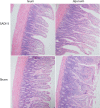Metabolomics analysis of stool in rats with type 2 diabetes mellitus after single-anastomosis duodenal-ileal bypass with sleeve gastrectomy
- PMID: 36204098
- PMCID: PMC9530139
- DOI: 10.3389/fendo.2022.1013959
Metabolomics analysis of stool in rats with type 2 diabetes mellitus after single-anastomosis duodenal-ileal bypass with sleeve gastrectomy
Erratum in
-
Erratum: Metabolomics analysis of stool in rats with type 2 diabetes mellitus after single-anastomosis duodenal-ileal bypass with sleeve gastrectomy.Front Endocrinol (Lausanne). 2023 Mar 28;14:1128339. doi: 10.3389/fendo.2023.1128339. eCollection 2023. Front Endocrinol (Lausanne). 2023. PMID: 37082128 Free PMC article.
Abstract
Background: Single-anastomosis duodenal-ileal bypass with sleeve gastrectomy (SADI-S) is one of the most effective bariatric procedures in the treatment of type 2 diabetes mellitus (T2DM). However, the mechanisms by which SADI-S improves T2DM are not well-known.
Objective: To explore the effects of SADI-S on metabolites in the stool of rats with T2DM.
Methods: Twenty rats were fed on high-fat diet and administered with a low-dose (30mg/kg) of streptozotocin to establish T2DM models. The rats were then randomly assigned to the SADI-S group (n=10) and sham operation group (n=9). Stool samples were collected from all rats at 8 weeks after surgery and stored at -80 °C. Metabolomics analysis was performed to identify differential metabolites through ultra- performance liquid chromatography-mass spectrometry.
Results: At 8-week after surgery, rats of the SADI-S group showed significantly decreased fasting blood glucose, glucose tolerance test 2-hour, glycated haemoglobin, and body weight compared with those of the sham group. A total of 245 differential metabolites were identified between the two groups. Among them, 16 metabolites such as branched-chain amino acids (valine), aromatic amino acid (phenylalanine), bile acid (cholic acid, lithocholic acid, and β-muricholic acid), short-chain fatty acid (isobutyric acid), and phospholipid [lysoPE(17:0), lysoPE(20:3) and lysoPS(16:0)] were associated to the T2DM remission after SADI-S.
Conclusion: SADI-S improves T2DM in rats by regulating phenylalanine biosynthesis, valine, phenylalanine, alanine, glutamate, proline, bile acid, and phospholipid metabolism pathways.
Keywords: SADI-S; T2DM; bariatric surgery; metabolomics; single-anastomosis duodenal–ileal bypass with sleeve gastrectomy; type 2 diabetes mellitus.
Copyright © 2022 Wang, Wang, Yu, Ren, Jia, Wang, Li and Jiang.
Conflict of interest statement
The authors declare that the research was conducted in the absence of any commercial or financial relationships that could be construed as a potential conflict of interest.
Figures






References
-
- International Diabetes Federation . IDF diabetes atlas. 10th edn. Brussels,Belgium: International Diabetes Federation; (2021). Available at: https://diabetesatlas.org/atlas/tenth-edition/.
-
- Kashyap SR, Bhatt DL, Wolski K, Watanabe RM, Abdul-Ghani M, Abood B, et al. . Metabolic effects of bariatric surgery in patients with moderate obesity and type 2 diabetes: Analysis of a randomized control trial comparing surgery with intensive medical treatment. Diabetes Care (2013) 36(8):2175–82. doi: 10.2337/dc12-1596 - DOI - PMC - PubMed
-
- Mingrone G, Panunzi S, De Gaetano A, Guidone C, Iaconelli A, Capristo E, et al. . Metabolic surgery versus conventional medical therapy in patients with type 2 diabetes: 10-year follow-up of an open-label, single-centre, randomised controlled trial. Lancet (2021) 397(10271):293–304. doi: 10.1016/S0140-6736(20)32649-0 - DOI - PubMed
Publication types
MeSH terms
Substances
LinkOut - more resources
Full Text Sources
Medical

